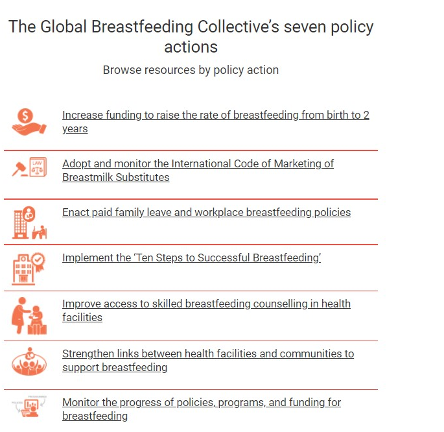Breastfeeding and mothers’ milk is presently not counted in food systems or the economy and should be, argues Dr Julie Smith. She explains the new ‘Mothers’ Milk Tool’ quantifies the volume of breastmilk and the value of breastfeeding at national and global levels.
Why do we need the Mothers’ Milk Tool?
When a farmer feeds her children milk from a cow, the value of the milk counts in Gross Domestic Product (GDP), but when she breastfeeds, it counts for nothing.
Why is breastfeeding not counted, and what are the consequences?
Breastfeeding and mothers’ milk is presently not accounted for in our food systems or the economy.
Economic statistics are built on a system established by the Organisation for Economic Co-operation and Development (OECD) in the 1950s. It became an international rule, and lead to the fact that many countries do not count the unpaid work done within households or women’s food production as crucial to the local and family economy. Only economic activities done for others – and for monetary reward – count in this statistical system.
Feminist critique
Excluding unpaid household production from measurement has been strongly criticized by feminist advocates. Marilyn Waring scathingly critiqued the so-called System of National Accounts (SNA) – the internationally agreed standard set of recommendations on how to compile measures of economic activity. In her book, If women countedDame Marilyn Waring describes the SNA as ‘applied patriarchy’.
Since then, estimates have shown that if given a monetary value, unpaid household work is equal to over 40% of the value of GDP.
Policy analysis and impacts
There have been strong critiques of the delay in reforming the SNA.
OECD economists have recently shown that GDP overstates the true growth rate of economically valuable production. This is because there is now more use of paid childcare services instead of unpaid care. The growth of GDP is misleading because it fails to account for the shift away from the unpaid childcare that was provided – mostly by women – in the household sector, to the monetized economy, and misleadingly measures this shift as boosting economic growth rates.
Over a decade ago, breastfeeding and human milk was used as an example of the same problem, in a review of the SNA commissioned by the French President. The Nobel Prize winning economists Joseph Stiglitz and Amartya Sen who led the review wrote that:
There is a serious omission in the valuation of home-produced goods—the value of breast milk. This is clearly within the System of National Accounts production boundary, is quantitatively non-trivial and also has important implications for public policy and child and maternal health.
Human milk production should be counted
From the early 1990s, the rules of the SNA were slightly changed so that production of goods, can be counted in GDP if there is a suitable market price that can be used to impute value to it. So for example, the Australian Bureau of Statistics makes a rough count of backyard vegetable garden production, and on-farm consumption of milk and eggs, and counts the monetary value of these in GDP figures using market-based pricing.
However, unpaid ‘services’ such as childcare or breastfeeding remain outside the core measure of GDP, which is commonly used to describe countries’ economic growth and progress.
Research has shown that the monetary value of unpaid childcare, for example, in Australia is several times the size of the childcare industry. Other studies in Korea and China show similar results.
Gender responsive budgeting and breastfeeding
Money is the language of policymakers, and what is not visible is often not valued. This can reduce the priority given to the needs of new mothers in government policy and budgets.
To advance women’s human rights and improve budget transparency, gender responsive budgeting (GRB) has been introduced in a number of countries in recent decades, and encourages better collection of relevant data, and greater representation of women in policy decision-making. Gender budgeting helps to address hidden biases in public policies and programs, and in budget funding. The Victorian parliament is moving to introduce GRB.
The ANU ran a series of webinars applying gender budgeting to breastfeeding during 2020.
Despite a national breastfeeding strategy being prepared and agreed by all Australian jurisdictions, it lacks funding for implementation. A gender budgeting lens and the Mothers Milk Tool can help highlight the need to resource this important strategy, in order to implement better breastfeeding protection, promotion and support in Australian health services and employment or other settings.
This gender budgeting approach informed a call for the federal budget to provide for better planning and preparedness for infant and young child feeding in emergencies, something that WBTI Australia, part of a global women’s advocacy group, identified as a key gap for Australia in its 2018 Report.
Counting breastfeeding as a first food system
Breastfeeding is the first food, and there are risks of ignoring this healthy and sustainable first-food system in economic statistics and policymaking.
In countries with a large subsistence sector, the SNA changes in 1993 were an important recognition of women’s important economic role as food producers. The change meant that human milk can be counted in GDP. However, in most countries it still isn’t, though in Norway it has been counted as part of the country’s food supply for decades.
GDP rules exclude breastfeeding because it is classified as a ‘service’, not a ‘good’. GDP rules do provide for human milk to be counted in economic statistics where it is feasible to count its production volume and to find a price for a comparable product so it can be given a monetary value.
Counting mothers milk in economic statistics
Previous studies have estimated how much milk breastfeeding mothers produce each year. This data can provide better scientific information for public policy and budgeting decisions and reduces the invisibility of women’s productivity including breastfeeding.
The new ‘Mothers’ Milk Tool’ will help to make the value of breastfeeding more visible by making such calculations easier.
The Mothers’ Milk Tool quantifies the volume of breastmilk and value of breastfeeding at national and global levels, as well as how much is lost if country environments and policies, or healthcare, work and community settings do not enable women’s and children’s rights to breastfeeding.
For example, the Mothers’ Milk Tool conservatively estimates that globally, around 35.6 billion liters of milk a year is produced by breastfeeding mothers of children 0-3 years. Each year, the world loses around a third of the biologically feasible potential, a loss of value of more than US$2.2 trillion. In Australia, human milk production amounts to around 51 million litres a year.
There are various ways a monetary value can be attributed to this, but at the cost of fresh donor milk of around $100 a liter, this is valued at over A$5 billion a year.
Such data draws attention to the need for measures to prevent or address declines in breastfeeding, such as maternity protection, Baby Friendly Hospitals, and control of baby food marketing.
The World Health Organization recommends breastfeeding exclusively for 6 months and continuing with safe and adequate complementary foods to 2 years and beyond, and together with UNICEF in the Global Breastfeeding Collective, has called for governments to take key 7 key actions on breastfeeding, including better monitoring of progress.

The Global Breastfeeding Collective has identified seven policy priorities for countries to protect, promote and support breastfeeding.
The Tool also allows individual mothers to calculate how much milk they have produced for their child and its value, depending on how many months the child is breastfed for during the first 36 months of life. For example, a mother who breastfeeds to 6 months and then continues breastfeeding her child to 3 years will provide around 431 litres for her child. A child breastfed to 12 months will benefit from 211 liters of this uniquely valuable milk, and if it were paid for, would be akin to a gift of at least A$30,000. Of course, every drop counts!
The Australian National University and Alive & Thrive Southeast Asia have partnered to develop this easy to use, open source and downloadable tool that quantifies the economic value contributed to society by women’s unpaid care work through breastfeeding of infants and young children.
The Mothers’ Milk Tool will be of value to a variety of users, including policymakers, advocates, researchers, national accountants and statisticians, and individual mother/baby dyads. It can support tracking of progress on breastfeeding targets, by assisting food and health policymakers and public officials to include breastfeeding in food balance sheets and economic statistics.
The Mothers Milk Tool was launched in May, when most countries celebrate Mothers’ Day, to acknowledge the role, health and economic contribution of mothers to society through women’s unpaid care work, including breastfeeding. Professor Dame Marilyn Waring gave the opening remarks.
Measuring the value of mothers’ milk in monetary terms may be said to devalue it, and the value of breastfeeding and human milk is indeed far beyond its dollar value. However, counting human milk production in food and economic statistics will assist in better policy decision-making and investments in women’s unpaid care work.
To find out more, and try out the Tool for yourself, go to this website at the Australian National University.
- Please note: Feature image is a stock photo
Dr Julie Smith (BEc(hons)/BA (Asian Studies), PhD (Econs) is and Associate Professor of Public Health at the University of Canberra's Health Research Institute. She's an awarded Australian Research Council Future Fellow. Her recent research has focussed on feminist economic aspects of breastfeeding and regulation of markets in human milk.





